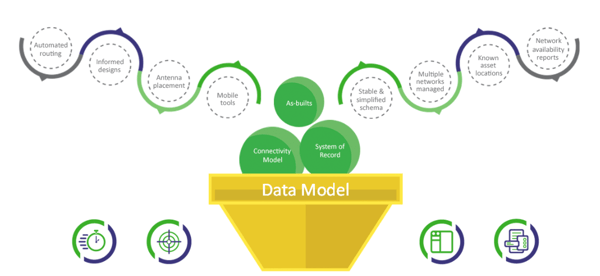The network is a multi-generational endeavor. It is ever changing from copper and coax to fiber and wireless. From planning and designing routes and rolling out construction crews, to operating and eventually expanding the network to accommodate new offerings, service providers are looking to streamline their view and management of all their assets at every stage of their use. To ensure they are getting the greatest value out of their network, an advanced network management system will have to be implemented. But what does it mean to have management solutions for the life-of-the-network? And how is that kind of solution established?

What is a life-of-the-network solution?
The necessity of a solution that is effective for a network’s entire lifetime is driven by the desire to make more informed and financially viable business decisions. Service providers are inundated with data from their engineering and construction firms during the planning, designing, and building phases of the network, but rarely does that data have purpose after the construction is completed. The implementation of a life-of-the-network solution allows for that data to be utilized beyond the initial stages of the network, into the management and operation of the network and the business as a whole.
With a life-of-the-network solution, having their physical network data accessible empowers service providers to manage network utilization, availability, construction status, and risk mitigation. By streamlining the view of the network’s utilization and availability, service providers can quickly determine how much fiber, copper, coax, you name it, they have ready to turn up or lease to another provider. This easy revenue recognition expedites their time to return on investment. Being able to restore outages as rapidly as possible is another key to maximizing ROI. Having a solution that allows service providers to determine where an outage has occurred provides them the ability to roll out trucks to a precise location, saving their crews time in the field, and saving themselves money.

How is this kind of solution established?
The benefits of a life-of-the-network solution make the idea of adoption very tempting, but how do you build and execute it? It comes down to having a robust data model that can accommodate the network now and the network in the future. That sounds great, but what does that kind of data model look like? Most importantly, it has to start with “clean” data. If data is inaccurate or corrupted, the data model will not hold throughout the network, no matter how robust.
In order to take full advantage of the network data and truly have a generational management solution, the data model should facilitate automation techniques, virtual network technologies, and streamlined workflows. To achieve these functions as successfully as possible, the data model should incorporate a well-built connectivity model that provides as detailed information as possible about each physical network asset. A strand-level connectivity model allows for the streamlined view and management of the network utilization, availability, and risks that were mentioned earlier.
As a service provider, adopting this kind of data model and extending it through to your engineering and construction firms, provides you with a consistent data format that can easily be ingested in the system to quickly view your entire network in one system, not just a piece of it. As an engineering and construction firm, utilizing this kind of data model allows you to deliver data faster, and faster, better data leads to more contracts and increased revenue.
Want to learn more about getting the most value out of your physical network data and building a data model that provides solutions for the life-of-the-network? Watch our webinar with Telecoms.com to hear more from the experts. Click here to watch the recording.
.png)


